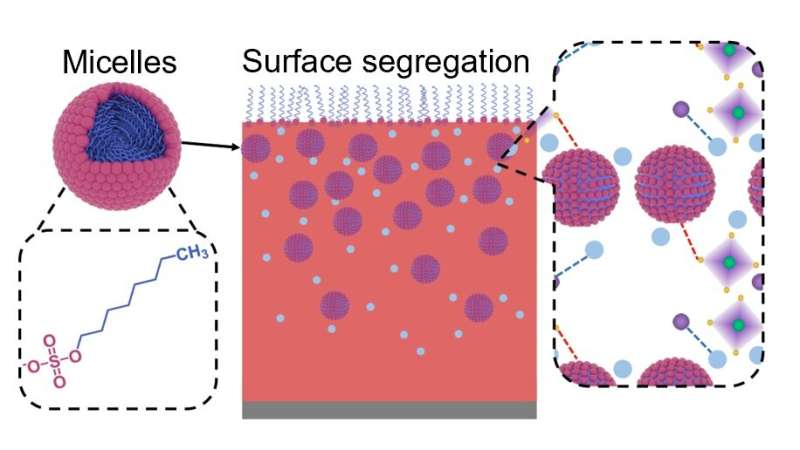This article has been reviewed according to Science X's editorial process and policies. Editors have highlighted the following attributes while ensuring the content's credibility:
fact-checked
peer-reviewed publication
trusted source
proofread
Novel additive helps improve stability of perovskite/silicon tandem solar cells

Prof. Ye Jichun's team at the Ningbo Institute of Materials Technology and Engineering (NIMTE) of the Chinese Academy of Sciences (CAS) has developed a long-alkyl- chain anionic surfactant (LAS) additive that can significantly improve the long-term operational stability of perovskite/silicon tandem solar cells. The study was published in Nature Communications.
Thanks to the rapid development of the power conversion efficiency (PCE), which has jumped from 13.7% to 33.2% over the past eight years, perovskite/silicon tandem solar cells have a promising future. However, the relatively low stability of perovskite active layers still hinders the development and commercialization of perovskite/silicon tandem devices.
Traditional methods to improve the stability include encapsulation, crystallization engineering, and defect passivation. Similar to "stress corrosion" in metals, glass and polymers, subcritical perovskite deterioration inevitably occurs due to tensile stress during the fabrication and operation, which degrades device performance.
To suppress the "stress corrosion," the researchers developed a novel LAS additive for the perovskite/silicon tandem solar cells.
By virtue of the surface segregation and micellization, the LAS additive can chemically modify the perovskite crystallization kinetics. Additionally, it can physically form a glue-like scaffold to eliminate the residual stress.
Due to the reduced defects, suppressed ion migration, and improved energy level alignment, the unencapsulated perovskite and perovskite/silicon tandem solar cells exhibited excellent operational stability.
Under continuous light illumination, the LAS-modified single-junction perovskite and dual-junction perovskite/silicon tandem devices can retain 85.7% and 93.6% of their original PCE after 3,000 hours and 450 hours of maximum power point tracking, respectively, which are among the best stabilities reported to date under similar conditions.
The innovative approach of this study may provide insight into the commercial production and large-scale application of highly stable perovskite/silicon tandem solar cells.
More information: Xinlong Wang et al, Long-chain anionic surfactants enabling stable perovskite/silicon tandems with greatly suppressed stress corrosion, Nature Communications (2023). DOI: 10.1038/s41467-023-37877-z

















